Hyundai Engineering & Construction, Westinghouse and Kozloduy NPP - New Builds have signed an engineering contract for new capacity at Bulgaria's Kozloduy nuclear power plant. ;
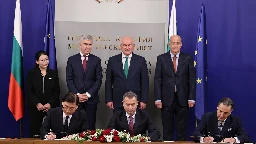
Hyundai Engineering & Construction, Westinghouse and Kozloduy NPP - New Builds have signed an engineering contract for new capacity at Bulgaria's Kozloduy nuclear power plant.
Bulgaria's Prime Minister, Dimitar Glavchev, speaking at the signing ceremony, said: "Bulgaria has 50 years of experience in the safe and secure operation of nuclear facilities. Today, we are building on this experience. Our work with the undisputed leaders Westinghouse and Hyundai on this project is a serious step towards the implementation of one of the government's main priorities related to the development of nuclear energy."
Energy Minister Vladimir Malinov said: "The development of nuclear energy in strict compliance with international standards for safety and environmental protection is one of the main priorities of the government. Our consistent efforts and active work together with our partners at Westinghouse and Hyundai in fulfilling this priority have led to today's result - the signing of an engineering contract for the new facilities. This is a key stage that makes the process irreversible."
He added that signing the contract meant that schedule and finance details would be firmed up within 12 months for the new capacity.
Kozloduy units 1-4 were VVER-440 models which the European Commission classified as non-upgradeable and Bulgaria agreed to close them during negotiations to join the European Union in 2007. Units 5 and 6 feature VVER-1000 reactors that were connected to the grid in 1987 and 1991, respectively. Both units have been through refurbishment and life-extension programmes to enable extension of operation from 30 to 60 years. The country's two operable reactors generate about one-third of its electricity.
The aim is for the first new Westinghouse AP1000 unit - unit 7 at Kozloduy - to be operational in 2035 and the second one - unit 8 - to be operational in 2037. The 2300 MWe capacity of the two new units would exceed the 1760 MWe capacity of the closed first four units. The Bulgarian government has also said that further units will be needed to replace units 5 and 6 by 2050.
The first of two demonstration Guohe One (CAP1400) reactors at Huaneng Group's Shidaowan site in China's Shandong province has been connected to the grid. The 1400 MWe pressurised water reactor design is intended to be deployed in large numbers across the country, as well as for export. ;

The first of two demonstration Guohe One (CAP1400) reactors at Huaneng Group's Shidaowan site in China's Shandong province has been connected to the grid. The 1400 MWe pressurised water reactor design is intended to be deployed in large numbers across the country, as well as for export.
The CAP1400 is an enlarged version of the CAP1000 PWR developed from the Westinghouse AP1000, with consulting input from the USA-based company.
Research and development for Guohe One began in 2008. In December 2009, the State Nuclear Plant Demonstration Company – a 55-45% joint venture company by State Power Investment Corp (SPIC) and China Huaneng Group – was set up to build and operate two demonstration unit of the CAP1400 at Huaneng's Shidaowan site at Rongcheng. SPIC officially launched the CAP1400 reactor design in September 2020.
Construction of unit 1 started in June 2019 and unit 2 in April 2020. The reactor design is expected to take 56 months to build, with later units coming down to 50 months.
The National Nuclear Safety Administration issued an operating license for the first Guohe One demonstration reactor in late July this year.
Speaking at a press conference on 31 October, Dong Wancheng, deputy director of the Development Planning Department at the National Energy Administration (NEA), announced that the first CAP1400 unit at Shidaowan had been successfully connected to the grid.
The reactor will now undergo gradual power ascension testing and trial operation verification before officially entering commercial operation.
"After it is put into operation, the annual power generation will be 11.4 billion kilowatt-hours, which can meet the electricity needs of more than 11 million residents and reduce greenhouse gas emissions by more than 9 million tonnes per year," NEA noted.
It added: "Since 2022, several CAP series third-generation nuclear power units under the State Power Investment Corporation have been approved to start construction, and this series of nuclear power models will usher in a peak period of construction in the next few years."
In May 2016, the CAP1400 design successfully passed the International Atomic Energy Agency's Generic Reactor Safety Review. This review is not a clearance process but a review of the quality of the safety documents identifying strengths, weaknesses and gaps. International use of the CAP1400 is still dependent on meeting country-specific standards and requirements, but passing the IAEA safety review will make this process easier.
Hualong One unit scheduled for commercial operation in 2025
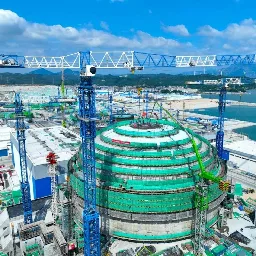
China has completed pouring concrete over the outer dome of the containment building for the Zhangzhou-2 nuclear power plant under construction in Fujian province, southeastern China.
According to the China Nuclear Energy Association (CNEA), the move marked the completion of the main structure and paves the way for cold functional testing at the plant.
Zhangzhou-2 is a domestic 1,126-MW HPR1000, or Hualong One, pressurised water reactor (PWR).
Construction began in September 2020 and the unit is scheduled for commercial operation in 2025, according to earlier reports.
There are three other Hualong One PWRs under construction and commissioning at the site. Last month, China National Nuclear Corporation (CNNC) said it started fuel loading at Zhangzhou-1.
Construction of Zhangzhou-3 and -4 began in Feb 2024 and Sep 2024.
The Hualong One is an indigenous, three-loop pressurised water reactor. It incorporates elements of CNNC’s ACP1000 and China General Nuclear’s ACPR1000+ reactor designs.
It is Beijing’s domestic flagship reactor technology, with 17 of the 28 reactor units under construction in China being of the Hualong One design. There are also two Hualong One plants in operation outside China, both in Pakistan at the Kanupp nuclear station, also known as Karachi.
Susquehanna owner Talen says Ferc erred and ‘we are evaluating our options’
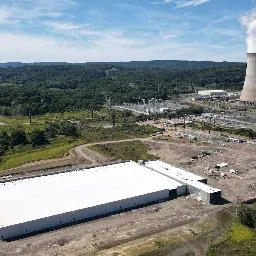
The US energy regulator’s rejection of a special deal that would have allowed an Amazon Web Services (AWS) data centre to use more power from a nuclear power station will have a chilling effect on economic development in states such as Pennsylvania, Ohio, and New Jersey, the station’s operator has said.
Federal Energy Regulatory Commission (Ferc) commissioners voted 2-1 against a proposal that would have increased the amount of power supplied to an Amazon data centre next to the Susquehanna nuclear facility owned by Talen Energy.
The commissioners said the plan, which was an amendment filed by the regional grid operator on behalf of the parties, did not adequately prove why the special contract should be allowed under federal rules.
The plan would set a precedent and the issues should be reviewed more closely, they said.
Ferc chairman Willie Phillips dissented, saying that the grid operator addressed reliability issues and called the order “a step backward” for both electricity reliability and national security.
Talen believes Ferc erred and “we are evaluating our options” with a focus on commercial solutions. “We believe this ISA [interconnection service agreement] amendment is just and reasonable and in the best interest of consumers.”
In March, AWS paid Talen $650m (€596m) for a 960-MW data centre campus next to the Susquehanna station in Pennsylvania, and signed a long-term agreement to buy power from the plant.
The data center, Cumulus Data Assets, sits on a 1,200-acre (485 hectares) campus in Pennsylvania and is directly powered by the adjacent Susquehanna Steam Electric Station, which generates 2.5 gigawatts of power.
Talen Energy subsidiary Cumulus Data completed construction on the first building at the nuclear-powered data centre campus in January 2023.
In June, PJM Interconnection, which operates the eastern US grid, serving more than 65 million people, sought approval from Ferc to increase the amount of power used onsite to from 300 MW to 480 MW.
Utility owners American Electric Power and Exelon filed a complaint opposing the move, arguing that it could threaten grid reliability and raise customer rates.
Talen said its co-location arrangement with Amazon would bring service to the customer quickly and without expensive transmission upgrades necessary to serve large-load demand.
“But our direct-connect configuration is just one of several commercial solutions to the demand of large loads, and we are exploring other solutions as we move forward,” a statement said.
It said: “The data centre economy will require an all-of-the-above approach to satisfy the increased demand, including co-location such as Talen’s arrangement with AWS, hybrids that co-locate primary power behind the meter while using grid power for back-up, and front-of-the-meter connections to utility transmission. Talen looks forward to the continued dialogue.”
The federal order came on the heels of a day-long Ferc technical conference on the topic, which discussed the merits and challenges of co-locating data centres with existing power plants, also dubbed “behind-the-meter” demand.
AtkinsRéalis company Candu Energy Inc has announced it is entering into a special project with Canadian nuclear regulators to plan for a Pre-Licensing Design Review of the new Candu Monark reactor's suitability to be licensed and built in Canada. ;
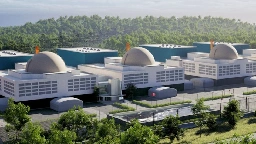
AtkinsRéalis company Candu Energy Inc has announced it is entering into a special project with Canadian nuclear regulators to plan for a Pre-Licensing Design Review of the new Candu Monark reactor's suitability to be licensed and built in Canada.
The 1000 MW Candu Monark, a Generation III+ reactor with the highest output of any Candu technology, was unveiled in November 2023. The conceptual design phase of the reactor was completed in September, and AtkinsRéalis plans to complete the preliminary engineering by 2027.
"Reactor development is a key differentiator for us as we have the exclusive licence to deploy one of only a few large reactor technologies available worldwide, and so we have extensive experience navigating the nuclear licensing process in Canada," said Joe St Julian, AtkinsRéalis President, Nuclear. "As the world enters a nuclear market super-cycle with estimated demand for 1,000 new reactor builds, we remain on track to complete the Candu Monark's design by 2027, positioning the first Candu Monark new build to begin as early as 2029 and be completed by the mid-2030s."
The special project will familiarise Canadian Nuclear Safety Commission (CNSC) staff with the design and allow them to provide feedback on what will be needed in a future pre-licensing design review.
The CNSC's optional vendor design review (VDR) process enables CNSC staff to provide feedback to a vendor early on in the design process. Such a review aims to verify, at a high level, that Canadian nuclear regulatory requirements and expectations, as well as Canadian codes and standards, will be met as well as helping identify, and potentially resolve, any fundamental barriers to licensing for a new design in Canada. AtkinsRéalis said it believes completion of a VDR was an added measure that offers predictability to a purchasing utility.
A typical VDR includes three phases, but since the Candu Monark's design heavily leverages the platform of past Candu reactor models which have fully completed all three phases of the regulator's VDR, as well as those that have already been licensed and built, the company said it has asked the CNSC to consider two possible types of pre-licensing design review: either a VDR, or a preliminary regulatory design assessment.
The special project between the CNSC and AtkinsRéalis will see the regulator's experts develop a schedule and estimate for both a VDR and a preliminary regulatory design assessment, reflecting the impact of the range of improvements and modernisations made to Candu Monark technology, their variance to past Candu designs that have already gone through all three VDR phases, and any relevant changes to regulatory requirements and expectations.
"AtkinsRéalis will then be able to evaluate which of these pathways will be most suitable in supporting the Candu Monark design programme, with the goal of seeking rigorous review and feedback on the Candu Monark's design in support of ensuring that any eventual Candu Monark new build project can be undertaken with confidence in the licensing costs and timeline," the company said.
Leadership of the UK's STEP (Spherical Tokamak for Energy Production) programme has transitioned to UK Industrial Fusion Solutions Ltd, a wholly-owned subsidiary of the UK Atomic Energy Authority. ;
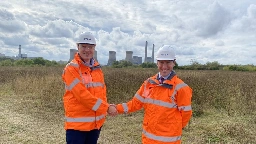
Leadership of the UK's STEP (Spherical Tokamak for Energy Production) programme has transitioned to UK Industrial Fusion Solutions Ltd, a wholly-owned subsidiary of the UK Atomic Energy Authority.
The establishment of UK Industrial Fusion Solutions Ltd (UKIFS) as a new delivery body for the UK's fusion programme was announced in February 2023 by then Science Minister George Freeman.
UKIFS will lead a public-private partnership that will design, build and operate the STEP prototype fusion plant at the West Burton power plant site in Nottinghamshire, England. The West Burton site was selected to host STEP in October 2022.
The UK Atomic Energy Authority (UKAEA) - which carries out fusion energy research on behalf of the government - said it will continue to be STEP's fusion partner, working alongside two industry partners – one in engineering and one in construction – to spearhead the development of a UK-led fusion industry.
"A major procurement exercise is currently under way to select STEP's strategic, long-term industry partners, with the shortlist expected to be announced by the end of the year," the UKAEA said.
"The launch of UK Industrial Fusion Solutions demonstrates significant progress and commitment to developing fusion as a viable clean energy source, and also to creating a UK-led fusion industry," said Paul Methven, CEO of UKIFS and Senior Responsible Owner for STEP. "STEP is a national endeavour with global impact, and we will continue to work closely with public and private sector partners to ensure the UK remains at the forefront of a revolutionary sustainable new energy source that will drive economic growth."
Ian Chapman, CEO of UKAEA, said: "UKIFS brings together an experienced team dedicated to translating decades of fusion research into a functioning prototype plant that will be capable of supplying low-carbon, safe, and sustainable energy to the grid. UKIFS will integrate partners in a national endeavour to build STEP as well as focussing on delivering enormous social and economic benefits to the UK, especially for the East Midlands region where the plant will be built."
The aim for the first phase of work on STEP is to produce a 'concept design' by the end of this year. The UK government is providing GBP220 million (USD285 million) of funding for this part. The next phase of work will include detailed engineering design, while all relevant permissions and consents to build the prototype are sought. The final phase is construction, with operations targeted to begin around 2040. The aim is to have a fully evolved design and approval to build by 2032, enabling construction to begin. The demonstration plant is due to begin operating by 2040.
The technical objectives of STEP are: to deliver predictable net electricity greater than 100 MW; to innovate to exploit fusion energy beyond electricity production; to ensure tritium self-sufficiency; to qualify materials and components under appropriate fusion conditions; and to develop a viable path to affordable lifecycle costs.
US-based company Amentum has been awarded a contract worth an estimated EUR5.5 million (about USD6 million) to consult for the first-of-a-kind dismantling of steam drum separators at units 1 and 2 of the Ignalina nuclear power plant in Lithuania. ;
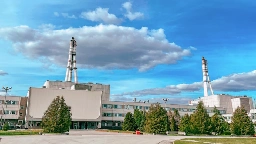
US-based company Amentum has been awarded a contract worth an estimated EUR5.5 million (about USD6 million) to consult for the first-of-a-kind dismantling of steam drum separators at units 1 and 2 of the Ignalina nuclear power plant in Lithuania.
The seven-year contract with Ignalina Nuclear Power Plant (INPP) will be implemented under International Federation of Consulting Engineers (FIDIC) Yellow Book Conditions, administered by the European Bank for Reconstruction and Development (EBRD) and funded by European Commission grants.
Lithuania assumed ownership of the two RBMK-1500 units - light-water, graphite-moderated reactors, similar to those at Chernobyl - in 1991, after the collapse of the Soviet Union. It agreed to shut down the Ignalina plant as a condition of its accession to the European Union, with unit 1 shutting down in December 2004 and unit 2 in December 2009. The reactors are expected to be fully decommissioned by 2038, with most of the cost of the decommissioning being funded by the European Union via the EBRD and other funds.
Amentum said it will provide consultancy services to support INPP's Project Management Unit and carry out the duties of FIDIC Engineer for the dismantling contract. It will help INPP to manage the removal of the steam drum separators, which are large drums installed over the graphite core to divert steam to the turbines. The Project Management Unit will oversee the design and safety justification for dismantling and fragmentation of the drums and associated equipment. These are located in the plant’s radiologically contaminated primary circuit.
"We will deploy our extensive nuclear decommissioning and waste management experience from the UK, France, Czechia and Slovakia to this ground-breaking project,” said Andy White, who leads Amentum Energy & Environment International.
Amentum was created in early 2020 from the spin-off of US-based global infrastructure firm AECOM's Management Services business. Through its heritage firms, Amentum has been working at Ignalina for more than 20 years on projects including the delivery of the New Interim Spent Fuel Storage Facility and other facilities required for decommissioning.
In September, Amentum completed a merger with Jacobs Solutions Inc's Critical Mission Solutions and Cyber and Intelligence government services businesses to form an independent, publicly traded company called Amentum Holdings, Inc. The combination was described by Amentum CEO John Heller as transformational for the company, forming a "global leader in advanced engineering and innovative technology solutions".
The International Atomic Energy Agency has reported that "a small water leakage was detected from an impulse line - essentially a small pipe - connected to" Zaporizhzhia nuclear power plant's first unit’s primary circuit, with repairs taking place and no "immediate...

The International Atomic Energy Agency has reported that "a small water leakage was detected from an impulse line - essentially a small pipe - connected to" Zaporizhzhia nuclear power plant's first unit’s primary circuit, with repairs taking place and no "immediate issue for nuclear safety".
According to the update from the IAEA, the repairs required the pressure in the primary circuit to be decreased to atmospheric levels and the operators of the plant - which has been under Russian military control since March 2022 - told them on Thursday the welding work had been completed and radiography checks of the welds were on-going.
Director General Rafael Mariano Grossi said: "The agency will continue to follow this issue closely, although we don’t see any immediate issue for nuclear safety. In general, we have identified regular equipment maintenance - which is vital to ensure sustainable nuclear safety and security - as a challenging area for the Zaporizhzhia nuclear power plant during the conflict."
All six of Zaporizhzhia's units have been in cold shutdown and, following this shutdown for maintenance, unit 1 is expected by the IAEA to be put back into cold shutdown.
The operators of the plant said on Telegram that a "microcrack in the pipeline was discovered and promptly eliminated", and after testing has confirmed the successful repair "it will be put into operation". The update added that radiation levels at the plant and surrounding area was unchanged.
The IAEA has had experts stationed at the Zaporizhzhia plant for more than two years, seeking to protect nuclear safety and security at the site, which is close to the frontline of the Ukrainian and Russian forces. The IAEA says the current team at the plant "continue to hear explosions daily, although no damage to the plant was reported".
There are also IAEA teams at Ukraine's three other operating nuclear power plants, with those at Khmelmnitsky reporting that drones had flown within 400 metres of the plant. Grossi said: "Frequent reports of drones flying near nuclear power plants continue to be a source of deep concern for nuclear safety and security. As we have stated repeatedly, any military activity in the vicinity of nuclear power plants represents a potential risk."
Nigerien government has pledged support for plans, but other miners have faced major setbacks

Global Atomic said it anticipates securing a project financing loan from a US development bank by early in the first quarter of 2025 to advance its Dasa uranium project in Niger.
The Canada-based company reported that in recent discussions, the bank confirmed its intention to approve a $295m (€271m) debt facility, which would cover 60% of the project’s projected costs.
Dasa is the highest-grade uranium deposit in Africa, surpassed only by grades found in Canada’s Athabasca Basin, and is scheduled to achieve commercial production in early 2026.
“The approval timelines outlined by the bank support yellowcake deliveries in 2026 as anticipated in the four offtake agreements we have in place with American and European nuclear power utilities,” said Global Atomic president and chief executive officer Stephen Roman.
“To help fund the continuing development of Dasa until the bank funds are available, earlier this month we raised CAD40 million [€26m, $29m] in an oversubscribed public offering.”
In addition to the unnamed development bank, Global Atomic is in discussions with parties regarding potential joint venture investment in the Dasa Project and other financing solutions, the company said.
According to Global Atomic, earthworks and civil engineering are progressing in preparation for the installation of plant equipment, components of which are now arriving at the site.
In August it emerged that the US development bank postponed a scheduled July presentation about the Dasa project to its credit committee, with Global Atomic saying it would move to “finalise other financing discussions” if there were further delays.
The Nigerien government has pledged its full support for the Dasa project, but other uranium developers in Niger faced major setbacks this past summer.
In June, Niger’s ruling military junta, which came to power following a coup in July 2023, revoked the operating licence of French company Orano at the Imouraren mine, which sits on one of the biggest uranium deposits in the world.
Orano said last week it would halt its uranium production in Niger from 31 October, citing a “highly deteriorated” situation and its inability to operate.
In July, Canada-based GoviEx Uranium said the junta had withdrawn its licence for the Madaouela uranium mine, dealing a major blow to the development of one of the world’s largest uranium projects.
The coup led the US to suspend government funding for Dasa. Still, the company managed to raise CAD15m in January and CAD20m in July by selling stock.
A consortium led by Belgian engineering firm Tractebel has completed the European Space Agency-commissioned RocketRoll project on nuclear electric propulsion for space exploration. The consortium has defined a comprehensive technology roadmap to equip Europe with advanced propulsion systems capable ...

A consortium led by Belgian engineering firm Tractebel has completed the European Space Agency-commissioned RocketRoll project on nuclear electric propulsion for space exploration. The consortium has defined a comprehensive technology roadmap to equip Europe with advanced propulsion systems capable of undertaking long-duration missions.
The RocketRoll project - or 'Preliminary European Reckon on Nuclear Electric Propulsion for Space Applications' - brought together leading stakeholders in aerospace and nuclear within a consortium led by Tractebel that includes the French Alternative Energies and Atomic Energy Commission (CEA), ArianeGroup, Airbus and Frazer Nash. It also included researchers from the University of Prague, the University of Stuttgart and engineers from OHB Czechspace and OHB System in Bremen.
The partners studied the feasibility of an electric nuclear propulsion (NEP) system where the electricity produced by a nuclear power reactor powers electric ion thrusters - ionising a gas and accelerating the ions produced, which are then ejected to generate thrust. This method's thrust is lower but continuous, and with far greater fuel efficiency it has higher speeds and could cut 60% off the Mars travel time of traditional chemical rockets.
"Thanks to its huge energy density, NEP offers disruptive advantages in terms of speed, autonomy, and flexibility," Tractebel said. "This innovative propulsion technology has the potential to transform space exploration and space mobility by enabling longer-duration missions, potentially shaping the future of interplanetary exploration."
The RocketRoll project, which started more than a year ago and concluded last month, has now submitted a technology roadmap to develop an NEP system, including a candidate design for a demonstrator spacecraft that could flight test NEP systems for deep space missions by 2035.
"I am proud to lead such an important initiative in nuclear electric propulsion, which could enable exploration and in-space logistics in Earth Orbit and beyond on a scale that neither chemical nor electrical propulsion could ever achieve," said Brieuc Spindler, Space Product Owner, Tractebel. "I am committed to navigating the intricate technical and strategic challenges ahead. By leveraging its nuclear expertise and innovative solutions, Tractebel helps advance space technologies and push the boundaries of the final frontier's exploration."
Currently, European space missions depend on external sources for nuclear capabilities. Tractebel says its strategy is to engineer a range of nuclear power solutions, from radioisotope to fission systems, while also contributing to developing a European value chain for nuclear solutions in space applications.
According to the European Space Agency: "NEP would enable exploration and in-space logistics in Earth Orbit and beyond on a scale that neither chemical nor electrical propulsion could ever provide. The ultimate raison d'être of NEP is to explore beyond Mars orbit where solar power is limited.
"In addition, NEP could have strong synergies with other space application. For instance, nuclear power could be used on the Moon or Mars surface to power future habitats or robotic exploration of the solar system, or in space for other purpose than propulsion."
A new strategic partnership between Kazakhstan and Mongolia's national atomic companies will provide new opportunities for the uranium industries of both countries, Kazatomprom's CEO has said. ;

A new strategic partnership between Kazakhstan and Mongolia's national atomic companies will provide new opportunities for the uranium industries of both countries, Kazatomprom's CEO has said.
The agreement to establish a partnership with MonAtom LLC was a "significant" result of the recent visit by President Kassym-Jomart Tokayev of Kazakshtan's recent official visit to Mongolia, Kazatomprom CEO Meirzhan Yussupov said. "The opportunities for implementing joint projects will allow us to combine resources and exchange experience and technologies, which will increase the efficiency and safety of uranium exploration and production," he said. "We strive for environmentally-friendly and safe development of the industry and are confident that this partnership will help to strengthen the positions of Kazakhstan and Mongolia in the international arena.
The new cooperation creates prospects for implementing joint projects in uranium exploration and mining in Mongolia, allowing both parties to strengthen their positions in the uranium industry, Kazatomprom said. "The companies plan to expand cooperation in the future and to consider a possibility of implementing joint initiatives aimed at strengthening the positions of Kazatomprom and MonAtom in the international uranium market," it added.
The agreement between Kazatomprom and MonAtom was reached during the state visit to Mongolia by President Tokayev, which also saw the signature of a Memorandum of Cooperation in the field of nuclear energy between Kazakhstan's Ministry of Energy and Mongolia's Atomic Energy Commission.
Tokayev and Mongolia's President Ukhnaa Khurelsukh welcomed the signing of the Memorandum of Cooperation in a joint declaration on strategic partnership between Mongolia and Kazakshtan issued at the conclusion of Tokayev's visit to Ulaanbaatar on 29 October.
Mongolia has substantial known uranium resources, although no uranium has been mined there since the closure in 1995 of an open-pit mine at the Dornod deposit in the north-east of the country. The Dornod mine was operated by Russian interests, and produced 535 tU during six years of production. Ore from the mine was transported by rail to the Priargunsky facility in Krasnokamensk, Russia, for processing.
French nuclear company Orano has had a presence in Mongolia since 1997, and is working to develop the Zuuvch Ovoo project - which it says has a potential 30-year mine life - through its Badrakh Energy joint venture with MonAtom.
Running my own instance, where do you change the max_pinned_statuses? All I find is a variable called PIN_LIMIT, not a value. Is this something you can change?
Holtec International said it repaired 125 damaged used fuel assemblies as part of the successful completion of its recent loading campaign of 480 used nuclear fuel assemblies into 15 HI-STORM FW dry storage casks at Angra unit 2 in Brazil. ;
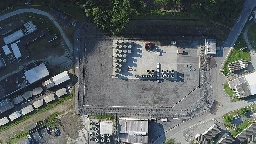
Holtec International said it repaired 125 damaged used fuel assemblies as part of the successful completion of its recent loading campaign of 480 used nuclear fuel assemblies into 15 HI-STORM FW dry storage casks at Angra unit 2 in Brazil.
Holtec said its team would return in early 2025 to load 75 damaged fuel containers from the Angra 1 site into 18 HI-STORM FW systems, also at the Complementary Dry Storage Unit for Spent Fuel (UAS).
Under a turnkey contract signed in 2017, Holtec of the USA supplied Eletronuclear with HI-STORM FW systems and related equipment for dry storage of used fuel from Angra units 1 and 2. Angra 1 is a Westinghouse-designed 609 MWe pressurised water reactor (PWR), while Angra 2 is a Siemens-designed 1275 MWe PWR. The units have different architectures and licensing bases, adding to the complexity of the project. Holtec modified their respective cask handling cranes and equipment for loading the fuel into the multi-purpose canisters and for moving the canisters to the dry storage facility.
PK Chaudhary, President of Holtec’s Nuclear Power Division with direct responsibility for Projects, Manufacturing & Supply Chain, said: "We thank Eletronuclear's team for their exemplary support for the Angra 2 used fuel storage campaign. We are gratified to see our innovative spent fuel storage solutions play a critical role at the Angra Nuclear Station. We look forward to a repeat success when our team returns to load used fuel at Angra 1 in early 2025."
The storage facility is designed to receive fuel elements after the cooling process in pools at the plants. They are stored in canisters made of steel and concrete to guarantee safety. It is a system which is used in the USA and is designed to withstand extreme events such as earthquakes and floods.
It includes physical security, radiation and temperature monitoring, an armoured access control centre and a storage warehouse with a technical workshop, designed and constructed by Holtec. The facility was constructed because the storage pools of both units were reaching full capacity. It is designed to hold up to 72 modules, with the capacity to receive used fuel until 2045.
Holtec said it used its Fuel Repair Device (FRD) to repair the damaged used fuel assemblies, technology which it used for the first time during refuelling at its Indian Point Nuclear plant in the USA last year. It says that its system renders a damaged fuel assembly that cannot be handled by normal means into one that can be handled in a normal manner using the plant’s existing fuel handling tooling and is "the only fuel repair technology available in the industry that involves no welding or introduction of any foreign material in the fuel pool".
Holtec says that in 2025 at Angra 1 it will load 18 HI-STORM FW systems with 75 damaged fuel containers and used fuel will be stored in MPC-37 canisters, each of which can contain 37 PWR used fuel assemblies.
The American Bureau of Shipping has released its latest report into the potential of advanced nuclear technology for maritime applications, with a study of a small modular reactor on a standard liquefied natural gas carrier. ;

The American Bureau of Shipping has released its latest report into the potential of advanced nuclear technology for maritime applications, with a study of a small modular reactor on a standard liquefied natural gas carrier.
The report notes that large liquefied natural gas (LNG) carrier vessels are increasing in demand as the international LNG trade remains important for global energy security. LNG is stored on board in large cryogenic tanks that maintain natural gas (primarily methane) in a liquid state around -165°C. The typical energy demand for LNG carriers is between 30 to 75 MW.
The scope of the American Bureau of Shipping (ABS) study - titled Pathways to a low carbon future: LNG carrier nuclear ship concept design - was to consider and discuss a standard LNG carrier design using nuclear power for propulsion and other primary energy needs. A conceptual future zero-emissions LNG carrier is presented to illustrate how one type of advanced nuclear fission technology may be applied for shipboard power in the future, with an emphasis on what aspects of ship and reactor design may require further investigation to guide the development of the integrated technology and regulatory framework.
The transformational impact of a high-temperature, gas-cooled reactor (HTGR) on the design, operation and emissions of a 145,000-cubic-metre LNG carrier design was modeled by ABS and Herbert Engineering Corporation. ABS said the study was designed to help industry "better understand the feasibility and safety implications of nuclear propulsion and to support future development projects".
The study shows a nuclear-propelled LNG carrier would have specific design features, with reactors placed at the rear of the vessel (to shield the cryogenic cargo from the thermal load of the reactor compartment) and batteries forward of the location occupied by fuel tanks on current vessels and a reinforced hull. Given design constraints, the HTGR technology would only be suitable for larger LNG carriers.
"The study provides ABS and the industry important information on heat and energy management, shielding, weight distribution, and other design features for an LNG carrier with nuclear propulsion," ABS said. "This will assist the identification of design issues that will inform future Rules development. The study also found the HTGR technology allowed faster transit speeds and offers zero-emission operations. There would also be no requirement to refuel, although the HTGR technology would need replacing approximately every six years."
ABS said the benefits from nuclear propulsion include decarbonised high-power availability, reduced or eliminated bunker costs, and associated reduced bunker time in port.
"Nuclear power would be an ideal means of drastically abating shipping emissions, but significant hurdles remain in public perception and international regulations before this can be achieved," it adds.
"While this technology is well understood on land, adapting it for marine application is in its infancy," noted ABS Senior Vice President and Chief Technology Officer Patrick Ryan. "However, this study and the other research we have carried out clearly highlight its significant potential to address not only shipping's emissions challenge but to deliver a range of other operational advantages to the industry. ABS is committed to helping the industry evaluate its suitability for use in a range of use cases and LNG carriers is just one of a range of potential applications we are exploring."
In August 2022, ABS announced it had been awarded a contract by the US Department of Energy (DOE) to research barriers to the adoption of advanced nuclear propulsion on commercial vessels. Working with support from DOE's National Reactor Innovation Center, based at Idaho National Laboratory, ABS is developing models of different advanced reactor technologies for maritime applications and developing an industry advisory on the commercial use of modern nuclear power.
In July last year, a study commissioned by ABS explored the potential of advanced nuclear reactor technology for commercial marine propulsion. ABS commissioned Herbert Engineering Corporation to carry out a study designed to help the shipping industry better understand the feasibility and safety implications of nuclear propulsion and to support future development projects. The study modelled the impact of nuclear propulsion on the design, operation and emissions of a container vessel and a Suezmax tanker.
The Czech Republic's competition authority has issued a preliminary ruling rejecting the appeals by Westinghouse and EDF about the tender process for new nuclear units in the country which saw Korea Hydro & Nuclear Power selected. ;
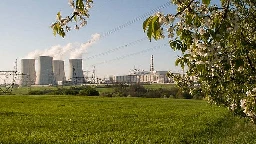
The Czech Republic's competition authority has issued a preliminary ruling rejecting the appeals by Westinghouse and EDF about the tender process for new nuclear units in the country which saw Korea Hydro & Nuclear Power selected.
In a ruling published on Thursday, the Office for the Protection of Competition (UOHS) said it had "decided in the first instance on the proposals of the companies Électricité de France and Westinghouse Electric Company LLC against the procedure of the contracting authority Elektrárna Dukovany II in the tender for the construction of a new nuclear power plant. The proceedings on the proposals of both companies were mostly terminated, while other parts of the proposals were rejected. The decisions are not final and the parties to the proceedings may lodge an appeal with the Chairman of the Office".
It said that Westinghouse's objection "against the procedure of the contracting authority outside the framework of the Public Procurement Act on the basis of the so-called security exception" did not proceed "because the company should have filed its objections to the use of the exemption no later than 15 days after it became aware of the use of this procedure, which was in March 2022. However, the objections were not received by the contracting authority until 1 August 2024".
It also says that "both applicants also argued that the contracting authority had acted illegally in failing to comply with the basic principles of public procurement ... for example, the substantial extension of the subject of performance of the public contract in question, the inability of the preferred supplier to perform the contract, etc". However this complaint was also not taken forward "because no legal objections can be raised against the specific procedure of the contracting authority in awarding the public contract outside the procurement procedure using the exception under Article 29(a) of the Public Procurement Act".
Both companies claimed that foreign subsidy regulations had been infringed, with EDF also alleging "a breach of the 3E principles as well", which refers to the benchmarking process for tenders. But the office "rejected the proposals in these parts because they were not directed against a procedure which the contracting authority is required to follow under the Public Procurement Act".
Because these are not final rulings the competition office added that "the prohibition to conclude a contract for the tender in question remains in effect until the decision in the case comes into force".
The ruling was published the day after it emerged that there was a ban on signing the contract pending a decision on the case. Speaking on Wednesday, Deputy Prime Minister Vlastimil Válek said that was "the standard procedure of the Office" and happens in many hundreds of cases a year "so it's nothing out of the ordinary - it's part of our legislation and I don't think it should jeopardise any of that timetable in any way".
ČEZ Group also issued a statement saying that its project company for the two new units, had "proceeded from the very beginning in accordance with the applicable laws" and it was "conducting negotiations with the preferred supplier, which is the Korean company KHNP, regarding the form of the final contract. According to the current schedule, it should be ready for signing by 31 March 2025. It can be expected that by then the ÚOHS will be able to make a decision in the proceedings so that the signing of the contract with the preferred supplier is not delayed".
The background
The Czech Republic currently gets about one-third of its electricity from the four VVER-440 units at Dukovany, which began operating between 1985 and 1987, and the two VVER-1000 units in operation at Temelín, which came into operation in 2000 and 2002.
In October last year, Westinghouse, EDF and KHNP submitted binding bids for a fifth unit at the Dukovany nuclear power plant, and non-binding offers for up to three more units - another one at Dukovany and two at the Temelin nuclear power plant. Westinghouse was proposing its AP1000, EDF was proposing its EPR1200 reactor, KHNP was proposing its APR1000. But in February the Czech government announced it was changing the tender to be binding offers for four new units, with Westinghouse not included because it "did not meet the necessary conditions".
Prime Minister Petr Fiala explained at the time that the decision to switch to binding offers for all four units was the result of the original tender suggesting that contracting for four units, rather than having separate processes, could have a 25% benefit in terms of costs.
In July, he announced KHNP as the preferred bidder, with contract negotiations to begin with the aim of signing contracts for the initial unit by the end of March 2025 - the target for test operation of the first new unit is 2036 with commercial operation in 2038. He said the winning tender "based on the evaluation of experts, offered better conditions in most of the evaluated criteria, including the price". The KHNP bid was for a cost of around CZK200 billion (USD8.6 billion) per unit, if two units were contracted.
Nuclear energy - including the nuclear supply chain - is at the core of the Government of Ontario's plans to build critical infrastructure and spur economic growth set out in its latest economic statement. ;

Nuclear energy - including the nuclear supply chain - is at the core of the Government of Ontario's plans to build critical infrastructure and spur economic growth set out in its latest economic statement.
The 2024 Ontario Economic Outlook and Fiscal Review: Building Ontario for You was released by Minister of Finance Peter Bethlenfalvy, who said the province's fiscal position had improved since the 2024 Budget which was released in March. The minister said the province - which is supporting both nuclear new-build and the refurbishment of existing units - will "continue investing responsibly to support Ontario’s growth and rebuild Ontario’s economy to make our province the best place to live, work and raise a family".
Nuclear already provides more than 50% of the province's power, and Ontario is building on its "nuclear advantage" to meet growing electricity demand, the review says. The government is working with Ontario Power Generation (OPG) to start planning and licensing for three additional small modular reactors (SMRs) at the Darlington New Nuclear project, in addition to the first phase plant, for which site preparation is already under way. It is also working with Bruce Power on pre‐development work for the first large‐scale nuclear build in more than three decades in Canada.
The Ontario government is also supporting OPG's plans to refurbish units 5-8 at the Pickering nuclear power plant, as well as ongoing refurbishment projects at OPG's Darlington and Bruce Power's Bruce plants.
It has also introduced the Ontario Sustainable Bond Framework, enabling Green Bonds to fund environmentally beneficial projects, including nuclear energy.
Supply chain
"Ontario’s expansion of nuclear energy is cementing the province’s position as a global leader in new nuclear technologies, creating new export opportunities that will drive economic growth," the review notes, highlighting recent trade missions to Romania and France, which have secured "significant deals totalling CAD360 million that will leverage the province’s nuclear expertise to create jobs for Ontario workers and grow its nuclear supply chain". (CAD360 million is about USD259 million.) OPG and other Ontario nuclear supply chain providers had previously signed major agreements worth around CAD1 billion to export nuclear products and services to other countries, including Poland, Estonia and the Czech Republic.
In addition, it is "leveraging the expertise of OPG and its subsidiary Laurentis Energy Partners to support a new collaboration agreement with SaskPower in the deployment of a small modular reactor in Saskatchewan". This would also create more jobs for the Ontario economy, the review says.
Earlier in October, Ontario's Independent Electricity System Operator issued an updated forecast projecting that power demand in the province will increase faster than previously expected over the next 25 years, with annual consumption rising from 151 TWh in 2025 to 263 TWh in 2050. This accelerated pace of demand growth is primarily due to the industrial sector, including additional electric vehicle supply chain manufacturing, and energy-intensive data centres, as well as an increasing population and focus on electrification.
Ontario's Independent Electricity System Operator (IESO) said the government's new vision document "reinforces the importance of several IESO initiatives under way to meet the growing needs of the province, such as the competitive procurement of new electricity generation and expanding energy efficiency programs that will help keep electricity affordable for all Ontarians".
Final decision on potential technologies expected in spring

Great British Nuclear (GBN) has issued an “invitation to negotiate” to the four companies that were chosen for the shortlist of the UK government’s small modular reactor (SMR) selection process.
GBN, the public body set up to drive the delivery of new nuclear energy projects in the UK, said that after these negotiations are concluded, the companies will be invited to submit final tenders, which GBN will then evaluate.
A final decision on which technologies to select will be taken in the spring. GBN said it will provide further updates in due course.
The four companies remaining in the process are GE Hitachi Nuclear Energy International, Holtec Britain Ltd, Rolls Royce SMR Ltd and Westinghouse Electric Company UK.
The two companies that were on an initial list of six, but were not included in the list of four, were EDF and US-based NuScale Power.
French state-owned utility and nuclear operator EDF said in July that it had pulled out of the competition after deciding to shift away from its indigenous Nuward technology to a design based on proven technology only.
The UK government gave no reason for NuScale’s failure to make the list of four. In November 2023, NuScale cancelled its first SMR project, in the US, as costs increased.
Industry Calls For No Delays
Tom Greatrex, chief executive of the London-based Nuclear Industry Association, said that whilst it is good to see the UK SMR competition reach this stage, what is critical is reaching a decision as soon as possible without any further delays to the now published timeline.
“Confidence in the UK government’s pronouncements on support for SMRs rests on fulfilling commitments made today,” Greatrex said.
“It is vital for supply chain confidence as well as driving the wider nuclear ambition.”
Greatrex called for the government to empower GBN to buy more sites, starting with Heysham, so “we can deliver a fleet of SMRs for clean, reliable, British power and good, skilled jobs”.
The SMR competition for UK government support was launched last year by the then Conservative government, as part of a strategy to replenish the UK’s dwindling nuclear power fleet, most of which is due to shut down by the end of the decade.
It has been running behind the initial schedule to award contracts by the end of summer 2024.
ABB will help ‘lay groundwork’ for Sealer-E prototype at Oskarshamn
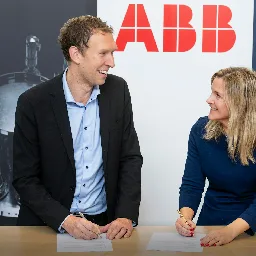
Sweden-based small modular reactor (SMR) developer Blykalla and global engineering company ABB have signed a memorandum of understanding to develop advanced nuclear reactor technology and potentially build an electrical SMR pilot facility near the existing Oskarshamn nuclear power station south of Stockholm.
Blykalla said the SMR pilot facility, which will not use nuclear fuel, will test proof of concept before expanding to future plants.
ABB, a Swedish-Swiss multinational, will explore how its automation, electrification and digitalisation solutions can support Blykalla’s SMR prototype the Sealer-E, which features an electric lead-cooled reactor. This includes cyber security frameworks to ensure compliance with nuclear safety regulations.
Lead-cooled nuclear plants are not yet operating, but are being developed as next-generation, or Generation IV, reactors. Lead has a very high boiling temperature of 1,749°C which means the problem of coolant boiling is for all practical purposes eliminated. This brings with it important safety advantages that also result in design simplification and improved economic performance.
ABB’s expertise of power distribution, control and automation technologies, and system integration, will “lay the groundwork” for a successful deployment of advanced nuclear technologies as part of the collaboration, a statement said.
Blykalla’s Sealer SMR plant uses liquid lead cooling and has what the company said are unique safety elements and proprietary innovations.
The company said it wants to provide baseload energy to enable a complete transition to a fossil-free future and is collaborating with partners to deliver Sweden’s next nuclear reactor within this decade.
Blykalla announced in September that it had doubled the capital raised in an early-stage investment round to €14m ($15.2m) as it seeks to industrialise its Sealer design.
Focus Is On Two Advanced Reactor Projects
Blykalla is focused on two projects – the construction of the electric Sealer-Enon-nuclear prototype test reactor at Oskarshamn and the development of its flagship advanced reactor design demonstrator the Sealer-One.
Blykalla said earlier that the funds announced in September will primarily be used for the construction of the prototype test reactor in collaboration with utilities OKG and Uniper, and the continued design and development of the Sealer-One.
The Oskarshamn prototype will be used for materials testing at high temperature, including testing of Blykalla’s innovative corrosion-tolerant steel alloys, which are expected to enable the efficient cooling of liquid lead.
Blykalla has also signed an MOU with Sweden-based nuclear engineering and services company Studsvik to conduct a feasibility study on the construction and operation of a demonstration Sealer reactor with associated infrastructure for fuel fabrication in Nyköping, south of Stockholm.
According to Blykalla, construction of the electric prototype reactor is expected to start at Oskarshamn by the end of 2024. A demonstration deployment of the actual Sealer-One lead-cooled reactor is expected by the end of the decade.
Sweden’s six commercial nuclear power plants provide almost 30% of the country’s electricity. In November 2023, the government unveiled a roadmap to expand nuclear energy, increasing new capacity by 2,500 MW by 2035 and building up to 10,000 MW by 2045, which could include SMRs.
EDF and Westinghouse have appealed decision to award contract to South Korea
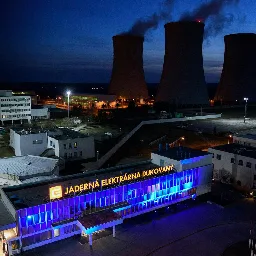
The Czech anti-monopoly office UOHS has put a temporary hold on the conclusion of a contract with South Korea’s state-owned Korea Hydro & Nuclear Power Company (KHNP) for the construction of two new nuclear power plants following challenges by Westinghouse and EDF.
UOHS said that the preliminary measure to prohibit the conclusion of the contract for new reactors at the existing Dukovany nuclear site was not indicative of how the case will be decided and was standard procedure in such a case.
The measure comes after the office started official proceedings work in September following appeals from US-based Westinghouse and France’s EDF against the country’s choice in July of KHNP as preferred bidder to build new nuclear reactors.
The Czech government and majority state-owned utility ČEZ have said they aim to conclude negotiations with KHNP and sign contracts by next March. The first reactor at the site could be online by 2036.
ČEZ said it believed the preliminary measure would not impact the tender's schedule. “The company is convinced it acted in accordance with the applicable laws from the first moment in the selection of the preferred bidder,” it said.
UOHS had said earlier that the complaint by EDF demanded that UOHS cancels decisions by a unit of the 70% state-owned ČEZ on evaluating bids.
The complaint by US-based Westinghouse focused on the use of a national security exception that suspended public procurement rules, it said. Westinghouse also appealed a decision not to be invited into the second round of the tender.
EDF has also filed a complaint with the European Union competition regulator over the decision to pick KHNP.
EDF said it wants to ensure that KHNP’s offer to ČEZ “respects fundamental European principles, laws and regulations”.
TerraPower has signed a term sheet with ASP Isotopes Inc for the construction of a uranium enrichment facility in South Africa and a supply agreement for fuel delivery for the Natrium small modular reactor. ;
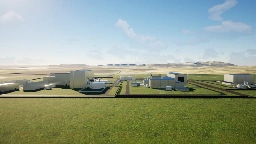
TerraPower has signed a term sheet with ASP Isotopes Inc for the construction of a uranium enrichment facility in South Africa and a supply agreement for fuel delivery for the Natrium small modular reactor.
The term sheet contemplates the preparation of definitive agreements pursuant to which TerraPower would provide funding for the construction of a high-assay low-enriched uranium (HALEU) production facility. In addition, the parties anticipate entering into a long-term supply agreement for the HALEU expected to be produced at this facility pursuant to which the customer would purchase all the HALEU produced at the facility over a 10-year period after the expected completion of the facility.
It is anticipated that the definitive agreements will be assigned to ASP Isotopes' wholly-owned subsidiary, Quantum Leap Energy LLC. The term sheet contains non-binding and binding provisions, including a period of exclusivity during which ASP Isotopes will not negotiate with third parties for the supply of HALEU or work on another ASP technology-based uranium enrichment facility.
ASP Isotopes said it is in discussions with certain financial institutions to provide additional capital for the HALEU production facility. The company said it believes that its enrichment technologies can be deployed in a new HALEU facility for considerably lower capital costs, and in much less time, compared with the construction of an enrichment facility using a traditional centrifuge process of HALEU production. ASP has already constructed or is in the process of constructing three isotope enrichment facilities in South Africa.
"Over the last several decades, the scientists at ASP Isotopes have developed some of the world's most advanced isotope enrichment technologies," said ASP Isotopes Chairman and CEO Paul Mann. "This term sheet is further validation of our belief that ASP Isotopes can offer scalable and capital efficient technology solutions to the supply challenges which exist in global isotope markets."
TerraPower said its agreement with ASP "is one of many investments TerraPower has made to secure access to the fuel for the Natrium reactor and energy storage system being developed in Kemmerer, Wyoming".
The company has also made multiple strategic agreements and investments to help spur domestic production capabilities in the USA and ensure a robust and competitive front end of the nuclear fuel cycle. These include MoUs and agreements with Centrus for HALEU commercialisation, Framatome to develop a HALEU metallisation plant and Uranium Energy Corporation to explore the use of Wyoming uranium as a potential fuel source for Natrium plants.
Once enriched, Natrium's fuel will be fabricated at the Natrium Fuel Facility in Wilmington, North Carolina, which is under development at the Global Nuclear Fuel–Americas site through a significant investment by TerraPower and the US Department of Energy (DOE). TerraPower also remains an active member and participant of DOE's HALEU Consortium.
"TerraPower has been working diligently to ensure a stable, secure HALEU supply chain for our Natrium reactors," said TerraPower President and CEO Chris Levesque. "This agreement is another example of our commitment and investments to commercialise HALEU production domestically and in allied countries. We are optimistic about ASP Isotopes enrichment capabilities and planned timeline to help ensure advanced nuclear energy can achieve its necessary role in meeting climate energy targets."
TerraPower broke ground for the first-of-a-kind advanced reactor plant at Kemmerer in Wyoming in June this year. The 345 MWe sodium-cooled fast reactor with a molten salt-based energy storage system - which can boost the system's output to 500 MW of power when needed, allowing it to integrate seamlessly with renewable resources - is being built near a retiring coal-fired plant.
Correct. In this case it's just shipping the component parts. I guess @KnitWit@lemmy.world was talking about PWR reactors that power these ships, much like the NS Sevmorput.
I think they might be referring to cargo like ammonia. What if we have a Beirut incident with a ship with a nuclear reactor? Something to plan ahead for sure.
Yucca mountain is a political problem, not a technical one. But sure, if you want examples of good practice, I refer to COVRA in the Netherlands, where I had a tour a few months ago. Very interesting facility. If you want a deep geological repository, there is Onkalo in Finland. I'm not a fan of dedicated DGRs, but since it's around, we might as well use it I guess.
In my view, should you care, we're not going to put away the spent fuel at all in these DGRs, but recycle them in until we used all of the fuel. At this point there actual waste, should we no longer be able to recycle this, is around 1% of the current 'waste' in volume and consists solely of short lived isotopes remaining radioactive for around 300 years. If you want to bury that, sure, I guess.
But please, now you tell us more about how fantastic the waste management is of the arsenic mining tailings in China, which are a result of digging for rare Earths to make solar panels. I look forward to it!
That's a nice analogy! Don't mind me if I use it in the future 👍
Before we can advance the use of solar panel use, the question of waste must be answered. Humans and corporations aren’t known for their responsibility.
See the double standard? No? I guess not.
Of any industry, the civilian nuclear industry has been exemplary in dealing with their waste streams, in contrast to all other energy industries. A waste stream that's actually highly recyclable and becomes no longer dangerous (unless you eat it) after just 300 years.
Nuclear waste is not an actually existing problem, and anyone raising it is employing a delaying tactic for our society moving away from fossil fuels actually killing our planet.
Nog update hierover? Outages gebeuren niet vaak, maar we waren ruim een uur (wat ik gemerkt heb) offline. Een mastodon account met status updates zou fijn zijn 🙂
Yes, vastly better. You just learned about SL-1 or something?
Public ownership would be a great idea, but it would still incur costs in the immediate sense. Things have to be updated and maintained.
"The blasting had been planned for 5.30pm but was delayed after a 36-year-old pro-nuclear protester scaled an electricity pylon near the towers in protest at their demolition."
Andreas Fichtner is now facing a legal battle for this protest. If you want to help out, please consider a donation.
Great overview, but I have two notes:
- A mention is made of the proliferation risks due to purified plutonium. But no mention is made of the difference between weaponsgrade Pu-239 and useless Pu-240. Pu-240 has the annoying characteristic that it can 'spontaneously' fission, which of course for is highly undesirable in warheads. These are mixed up and hard to separate. This simple fact makes proliferation risks at best a theoretical scenario.
- Vitrification of the fission products is explained well, but is still accompanied with the obligatory "hundreds of thousands of years" comment. This is incorrect. After 300 years, these fission products are no longer radiotoxic.
Several countries, and I guess Italy is among them, have decommissioning regulation where the old unit first has to 'cool off' for a few decades before the building can be torn down.
So, to answer of whether it is this or that, I answer: yes.
Did not expect this to go to any other company but a Russian one tbh.
Well, he knows about this community now! 🙂
So, you're then saying that nuclear is somehow more threatening to our future than fossil energy is? Wow. Thanks for being clear where you stand I guess.
Just for the record: fossil fuels not only change our planet's climate, it also kills millions of people each year due to air pollution.
